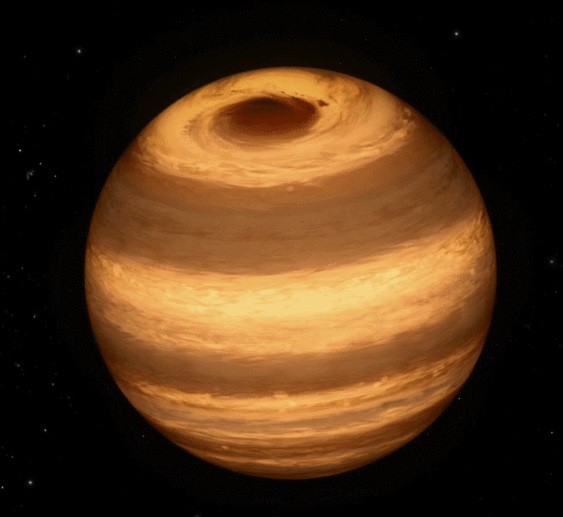Raging Giant Storm Found On Star As Big As Jupiter's Great Red Spot
| Ana Verayo | | Dec 14, 2015 06:30 AM EST |
(Photo : NASA/JPL-Caltech) This illustration shows a cool star, called W1906+40, marked by a raging storm near one of its poles. The storm is thought to be similar to the Great Red Spot on Jupiter. Scientists discovered it using NASA's Kepler and Spitzer space telescopes.
The Great Red Spot on the solar system's largest planet, Jupiter is also the biggest and longest existing storm in our neighborhood however, scientists detected a new "exo-storm" that can rival Jupiter's, located on a small, cool star.
Like Us on Facebook
This star is classified as an L-dwarf which are tiny stellar objects that possess both star and planet like characteristics, or more commonly known as a brown dwarf. Astronomers also call them as "failed stars" since brown dwarfs are too massive to be called as planets and too small to be named as stars. They are classified in between planets and stars even if they can weigh as much as Jupiter, even if they are similar in size, where they are cosmic anomalies with both qualities of stars and planets but are neither one of them.
Massive brown dwarfs are also known as M-dwarfs where they can emit low levels of fusion deep within their cores which is not enough to raise temperatures beyond a couple thousand degrees. This results in layered atmospheres that can also create weather patterns similar to planets like clouds and in this particular star, powerful storms.
Using NASA's Wide-field Infrared Survey Explorer they discovered this unusual brown dwarf called W1906+40 in 2011 where it is also detected by exoplanet hunter, the Kepler Space Telescope. Kepler usually detects exoplanets when these planets transit or block the light from their host star, causing dips in brightness. However, this time around, Kepler detected "starspots" which are dark patches of magnetic activity in the upper atmospheric, stratified layers of the star.
W1906+40's light emission is rather faint, however Kepler detected a large dark spot during the rotation of this L-dwarf. Astronomers first thought it was a dark cluster of star spots similar to our sun's periodical high magnetic activity.
By investigating further, researchers turned to the Spitzer Space Telescope that revealed a strange surprise, unlikely of a star. Using its infrared light, Spitzer determined how this large dark feature on W1906+40 is apparently not caused by magnetism and is not even close to a star spot but it was actually a massive, dark storm near its northern polar region.
According to lead author of the study John Gizis from the University of Delaware, this star is almost the same as Jupiter and its storm is also similar the size of the Great Red Spot. Also, this newfound storm is probably ongoing for at least two years or even longer. He adds that it is still unknown if this star storm is common or why it exists for so long.
This new study is published in The Astrophysical Journal.
TagsNASA kepler space telescope, NASA spitzer space telescope, brown dwarfs, jupiter like storm on star, jupiter great red spot, Exoplanets
©2015 Chinatopix All rights reserved. Do not reproduce without permission
EDITOR'S PICKS
-

Did the Trump administration just announce plans for a trade war with ‘hostile’ China and Russia?
-

US Senate passes Taiwan travel bill slammed by China
-

As Yan Sihong’s family grieves, here are other Chinese students who went missing abroad. Some have never been found
-

Beijing blasts Western critics who ‘smear China’ with the term sharp power
-

China Envoy Seeks to Defuse Tensions With U.S. as a Trade War Brews
-

Singapore's Deputy PM Provides Bitcoin Vote of Confidence Amid China's Blanket Bans
-

China warns investors over risks in overseas virtual currency trading
-

Chinese government most trustworthy: survey
-

Kashima Antlers On Course For Back-To-Back Titles
MOST POPULAR
LATEST NEWS
Zhou Yongkang: China's Former Security Chief Sentenced to Life in Prison

China's former Chief of the Ministry of Public Security, Zhou Yongkang, has been given a life sentence after he was found guilty of abusing his office, bribery and deliberately ... Full Article
TRENDING STORY

China Pork Prices Expected to Stabilize As The Supplies Recover

Elephone P9000 Smartphone is now on Sale on Amazon India

There's a Big Chance Cliffhangers Won't Still Be Resolved When Grey's Anatomy Season 13 Returns

Supreme Court Ruled on Samsung vs Apple Dispute for Patent Infringement

Microsoft Surface Pro 5 Rumors and Release Date: What is the Latest?










